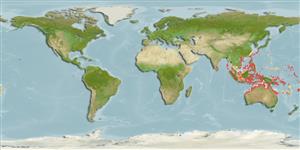Common names from other countries
>
Acanthuriformes (Surgeonfishes) >
Siganidae (Rabbitfishes)
Etymology: Siganus: Latin, siganus = a fish, rabbit fish; by the similarity of the nose (Ref. 45335).
More on authors: Fowler & Bean.
Environment: milieu / climate zone / depth range / distribution range
Ecología
marino asociado a arrecife; rango de profundidad 12 - 30 m (Ref. 9710). Tropical; 30°N - 24°S
Western Pacific: southern Ryukyu Islands, Palau (Belau), Philippines, northern Indonesia, Papua New Guinea, northern Queensland and reefs off northwestern Western Australia.
Tamaño / Peso / Age
Maturity: Lm ? range ? - ? cm
Max length : 35.0 cm SL macho / no sexado; (Ref. 48637); common length : 25.0 cm TL macho / no sexado; (Ref. 9813)
Espinas dorsales (total) : 13; Radios blandos dorsales (total) : 10; Espinas anales: 7; Radios blandos anales: 9; Vértebra: 13. Head and body dark chocolate brown with purplish hue; iris pale rose-brown, white spotted. Spines stout, pungent, venomous. Preopercular angle 93°-109°. Cheeks completely scaled. Midline of thorax scaled; a row of scales absent along pelvic ridges. Anterior nostril with low rim; expanded posteriorly into a broad flap, reaching halfway to posterior nostril.
Inhabits lagoon and channel reefs (Ref. 9710), usually near steep slopes and harbours (Ref. 48637). Usually seen in pairs. Feeds on benthic seaweeds (Ref. 9813).
Life cycle and mating behavior
Maturities | Reproducción | Spawnings | Egg(s) | Fecundities | Larva
Woodland, D.J., 1990. Revision of the fish family Siganidae with descriptions of two new species and comments on distribution and biology. Indo-Pac. Fish. (19):136 p. (Ref. 1419)
IUCN Red List Status (Ref. 130435)
CITES (Ref. 128078)
Not Evaluated
Threat to humans
Harmless
Human uses
Pesquerías: escaso valor comercial
Herramientas
Special reports
Download XML
Fuentes de Internet
Estimates based on models
Preferred temperature (Ref.
115969): 25.2 - 28.9, mean 27.7 (based on 166 cells).
Phylogenetic diversity index (Ref.
82804): PD
50 = 0.5000 [Uniqueness, from 0.5 = low to 2.0 = high].
Bayesian length-weight: a=0.01445 (0.00650 - 0.03213), b=3.08 (2.90 - 3.26), in cm Total Length, based on LWR estimates for this Genus-body shape (Ref.
93245).
Nivel trófico (Ref.
69278): 2.0 ±0.00 se; based on food items.
Resiliencia (Ref.
120179): Alto, población duplicada en un tiempo mínimo inferior a 15 meses (Preliminary K or Fecundity.).
Fishing Vulnerability (Ref.
59153): Low to moderate vulnerability (33 of 100).
